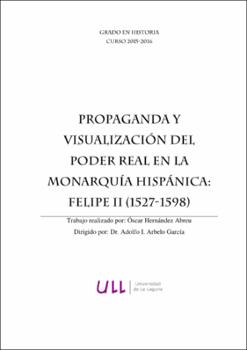Propaganda y visualización del poder real en la Monarquía Hispánica: Felipe II (1527-1598)
Author
Hernández Abreu, ÓscarDate
2016Abstract
La propaganda y visualización del poder real en el seno de la Monarquía
Hispánica fue una constante, desde sus orígenes en los Reyes Católicos hasta la
progresiva descomposición decimonónica del imperio español. El reinado de Felipe II
(1554-1598) representa el cénit del aparato propagandístico estatal destinado a crear una
imagen de la majestad tanto para bien como para mal, tanto para la Corte hispánica y las
grandes Cortes europeas, como para el resto del pueblo en cualquiera de los territorios
de la Monarquía. Aun así, este proceso de construcción de la figura del Rey no siempre
fue del todo fructífero, puesto que se crearon mitos y leyendas en torno a su persona y
episodios de su reinado que predominarían en el recuerdo de la producción literaria e
historiográfica durante siglos. The use of propaganda and the visualization of the royal power at the heart of
the Spanish Monarchy was a constant feature, from its origins in times of the Catholic
Monarchs to the progressive dissolution of the Spanish Empire in the 19th century. The
reign of Philip II (1554-1598) represents the zenith of the national propagandistic
branch which was destined to create an image of his Majesty in both a positive and a
negative sense, not only for the Spanish Royal Court and the other great European
courts, but also for the existent population in any of the territories dominated by the
Monarchy. Nevertheless, this process of construction of the figure of the king was not
always as fruitful as it may seem, due to the creation of myths and legends around his
character and the episodes related to his reign that would dominate the reminiscence of
the literary and historiographical production throughout the subsequent centuries.




